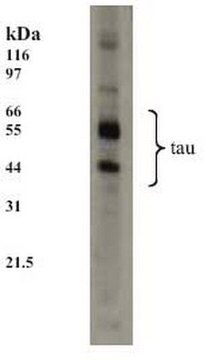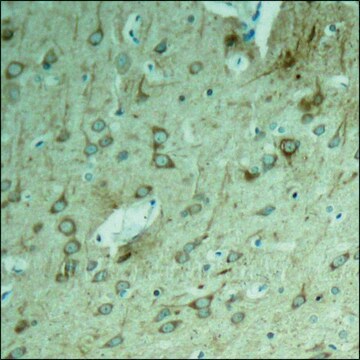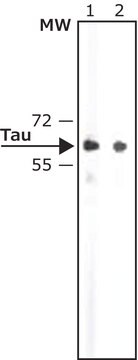General description
Microtubule-associated protein tau (UniProt: P10636; also known as Neurofibrillary tangle protein, Paired helical filament-tau, PHF-tau) is encoded by the MAPT (also known as MAPTL, MTBT1, TAU) gene (Gene ID: 4137) in human. Microtubule-associated protein tau is shown to be expressed in neurons. It is mostly found in axons, in the cytosol, and in association with plasma membrane components. Isoform PNS-tau is expressed in the peripheral nervous system while the others are expressed in the central nervous system. Nine isoforms of Tau have been described that are generated by alternative splicing. Tau proteins promote microtubule assembly and stability, and may also be involved in the establishment and maintenance of neuronal polarity. The C-terminus binds axonal microtubules while the N-terminus binds neural plasma membrane components, thus serving as a linker protein between both. The short isoforms are reported to allow plasticity of the cytoskeleton whereas the longer isoforms may preferentially play a role in its stabilization. In Alzheimer disease (AD), the neuronal cytoskeleton in the brain is progressively disrupted and replaced by tangles of paired helical filaments (PHF) and straight filaments, mainly composed of hyperphosphorylated forms of Tau. In AD brain Tau accumulates in both the somatodendritic and axonal domains of neurons and it also accumulates in the soma as neurofibrillary tangles (NFTs). Tau oligomers are reported to be neurotoxic when applied extracellularly to cultured neuronal cells and can induce neurodegeneration and synaptic and mitochondrial dysfunction in vivo.
Specificity
Clone 2A1-2E1 detects Microtubule-associated protein tau in human and murine brain. It targets an epitope within 19 amino acids from the N-termnal half.
Immunogen
KLH-conjugated linear peptide corresponding to 19 amino acids from the N-terminal half of human Microtubule-associated protein tau.
Application
Anti-Tau, clone 2A1-2E1, Cat. No. MABN2472, is a highly specific mouse monoclonal antibody that targets Microtubule-associated protein tau and has been tested for use in Immunohistochemistry and Western Blotting.
Research Category
Neuroscience
Western Blotting Analysis: A representative lot detected Tau in Western Blotting applications (Ishigaki, S., et. al. (2017). Cell Rep. 18(5):1118-1131).
Immunohistochemistry Analysis: A representative lot detected Tau in Immunohistochemistry applications (Ishigaki, S., et. al. (2017). Cell Rep. 18(5):1118-1131).
Quality
Evaluated by Western Blotting in human Tau-441 recombinant protein lysates.
Western Blotting Analysis: 2 µg/mL of this antibody detected Tau in human Tau-441 recombinant protein lysates.
Target description
~70 kDa observed; 78.93 kDa calculated. Uncharacterized bands may be observed in some lysate(s).
Physical form
Format: Purified
Protein G purified
Purified mouse monoclonal antibody IgG2a in buffer containing 0.1 M Tris-Glycine (pH 7.4), 150 mM NaCl with 0.05% sodium azide.
Storage and Stability
Stable for 1 year at 2-8°C from date of receipt.
Other Notes
Concentration: Please refer to lot specific datasheet.
Disclaimer
Unless otherwise stated in our catalog or other company documentation accompanying the product(s), our products are intended for research use only and are not to be used for any other purpose, which includes but is not limited to, unauthorized commercial uses, in vitro diagnostic uses, ex vivo or in vivo therapeutic uses or any type of consumption or application to humans or animals.








